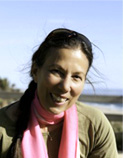Here are some Burma odds and ends…
Getting around: Hardly anyone in Burma owns a car. One particular folly of the regime has been to construct a gorgeous 4-lane highway between Mandalay and Rangoon. It’s deserted. The rest of the roads in the country range from awful to horrible, narrow strips of broken pavement that devolve more often than not into sand tracks.  The smooth, relatively unimpeded travel on the Chindwin River (except for that day our boat ran aground on a sandbar and we were marooned in the fog for hours) was a delight compared to travel by car. The vehicle of the masses is a small motorcycle, typically from China. Bullock carts with huge wood wheels, powered by Zebu/Brahmas of impressive size, are very much in use. So are rusty, one-speed bicycles and pedicabs.
The smooth, relatively unimpeded travel on the Chindwin River (except for that day our boat ran aground on a sandbar and we were marooned in the fog for hours) was a delight compared to travel by car. The vehicle of the masses is a small motorcycle, typically from China. Bullock carts with huge wood wheels, powered by Zebu/Brahmas of impressive size, are very much in use. So are rusty, one-speed bicycles and pedicabs.
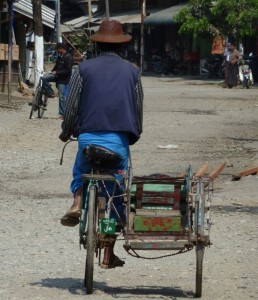
You tend to see cars only in major cities, such as Rangoon and Mandalay. It’s a dead give away who’s “in” with the regime, as they drive very shiny, new SUVs and fancy sedans. Apart from that, there are 30-year-old Toyotas, always white, generally Corollas. Since they were brought in from Japan, they have the steering wheel on the right, opposite to what you see in the U.S. But in Burma, traffic circulates as it does in the U.S., where we have the steering wheel on the left side of the car. As it happens, there are also cars in Burma with the steering wheel on the left hand, which makes for interesting viewing when you’re being driven around, as we were. If you see two people in the front seats of a car, you have no idea who’s driving until you’re right up next to them!
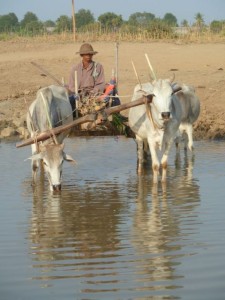
The streetscape: The streets, even in cities, are remarkably clean. And although Burma is a large country with nearly 59 million people, it does not feel congested with people the way India does. In fact, we were struck by how tidy and clean everything was, despite most structures being quite old.
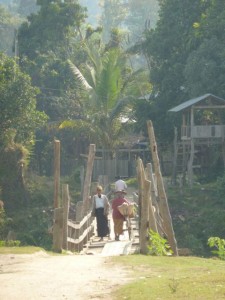
Everywhere we went we saw shopkeepers sweeping up the bits of paper and plastic that had been tossed during the day and burning them. That made for a very hazy, smoky air quality, but a nicer experience walking, that is if you can forget about the large number of red splats of spit on the sidewalk. Yes, paan, that mix of tobacco juice, a slice of areca nut and slaked lime wrapped in a betel leaf, is ubiquitous throughout Burma, chewed by men and women alike. Called kun-ya, it’s sold on every block from small glass carts and little kiosks. There’s a long tradition of chewing in Burma, but the deeply stained, red teeth and lips of the kun-ya chewers takes getting used to, as do the globules of red saliva one dodges on the street.

Markets: In Burma, which used to be the rice paddy of the world, before the military took over, the rice is delicious, and that’s said by someone who avoids rice whenever possible. They also have loads of vegetables: tiny yellow potatoes, sweet carrots, Roma tomatoes, cauliflower, eggplants, including a golf-ball size lavender and white one that stays crunchy when cooked.

There are always mounds of flavorful dried beans and lentils, wonderful shallot-sized red onions and garlic. And there are plenty of greens such as kale and mustard, along with interesting sour leaves from the tamarind and hibiscus, the latter called roselle and served in soups. And, of course, there are Asian things like bitter gourd and bitter green bell peppers and, yes, chilies. Meat is not a big part of the Burmese diet, but it is available in all markets, ranging from local chicken and ducks, to pork and beef. Eggs are plentiful, too. In the Chin Hills, the Chin natives raise an animal called a mithun, which is a sturdy, stocky and very cute hybrid of the wild gaur and a cow. Add the fruit that’s in season, which this time of year was watermelon, honeydew, papaya, mini-bananas and pineapples, plus several types of juicy and fragrant tangerines, and you have the makings of a bustling street market.
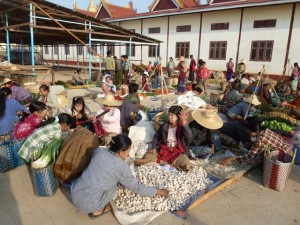
Burma’s a fascinating country and we surprised even our well-traveled selves by falling in love with the place.









